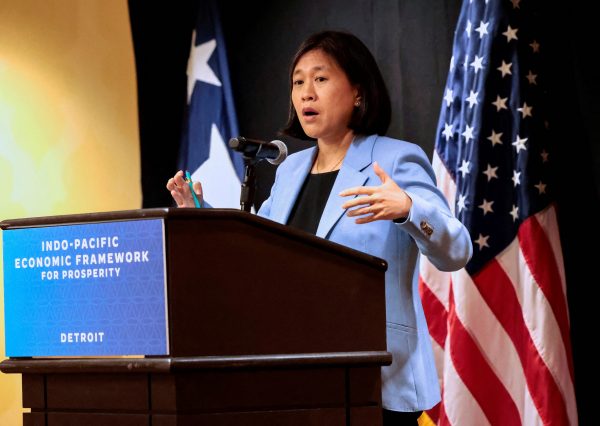Digital economy contributes to more than 15 per cent of global GDP according to the World Bank — much of this comes from digital trade, which spans from the trade of technological goods to digitally-enabled services.
Recently, approaches to digital trade are diversifying, especially in China and the United States. Both have increased their influence in digital transformation through various economic frameworks, including the Regional Comprehensive Economic Partnership (RCEP) and the Indo-Pacific Economic Framework for Prosperity (IPEF). RCEP is a thorough trade agreement that goes beyond trade liberalisation, including digital trade. The IPEF is also a substantial economic partnership that covers diverse sectors such as digital trade.
The IPEF was initiated by the United States on 23 May 2022, inviting Australia, Brunei Darussalam, India, Indonesia, Japan, South Korea, Malaysia, New Zealand, Philippines, Singapore, Thailand and Vietnam to join the framework. The IPEF aims to define shared objectives around four pillars — trade, supply chains, clean economy and fair economy.
The trade pillar highlights the urgency of digital trade cooperation and aims to promote an inclusive digital economy by increasing access to the internet and information, facilitating digital trade, resolving discriminatory practices and enhancing the security and resiliency of digital infrastructure.
Through the IPEF, the United States differentiates itself from China’s data sovereignty approach by encouraging free and open data flow. The IPEF seeks to reduce localisation requirements and limitations on cross-border data flows to promote more open digital trade. The IPEF further affirms its commitment to supporting reliable cross-border data flows, an inclusive digital economy with sustainable growth and responsible utilisation of emerging technologies — it is more extensive than RCEP.
By contrast, as the largest trading bloc, RCEP offers tariff adjustments, dispute settlement mechanisms and trade remedies that induce better cooperation and commitment to achieve common objectives. All ASEAN members and five external partners — Australia, China, Japan, South Korea and New Zealand — have signed it.
RCEP addresses digital trade as electronic commerce, referencing trade in traditional commodities delivered with the assistance of digital technologies. RCEP will create digital economy opportunities by promoting cooperation in research and training activities, capacity building and empowering small and medium-sized enterprises to utilise e-commerce platforms. This is an important benefit as digital trade is relatively new in the global trade regime and most RCEP members need different levels of assistance for digital transformation.
China plays a significant role in influencing the digital economy system for RCEP members. Its digital economy model has become the leader in the Indo-Pacific region. Several major Chinese companies — including WeChat and Alipay — have pioneered cross-border payments and developed practices that others can emulate. China’s digital economy has also produced many business opportunities.
By asserting its influence in RCEP, China is expected to contribute to the revitalisation of the digital trade regime in the Indo-Pacific region. Because of China’s growing influence, the IPEF may have been created because of the Biden administration’s concern about its weakening influence in Asia, rather than because of economic considerations.
RCEP comes with a take-it-or-leave-it approach which obliges member states to comply with provisions outlined in the agreement. But in implementing e-commerce provisions, RCEP respects the national interests of member states to determine appropriate measures that suit their circumstances.
In contrast, the IPEF adopts a flexible approach that allows member states to opt-out from any pillar they are not interested in, exemplified by India’s refusal to join Pillar 1 focused on trade. This renders some commitments of the framework unexecuted. If there is no guarantee that domestic reforms will be implemented equally, member states will be reluctant to initiate reformative steps, resulting in ineffective partnerships. The lack of economic incentives — including tariff adjustments — reduce the framework’s appeal to member states.
Regarding compliance mechanisms, RCEP members can resort to trade remedies and dispute settlement mechanisms. But RCEP’s e-commerce chapter does not fall under the jurisdiction of its dispute settlement mechanisms, making any disputes over interpretation and implementation subject to good faith negotiation. RCEP’s upcoming 5-yearly general review allows member states to re-evaluate whether these dispute mechanisms should apply to e-commerce-related disputes.
Yet the absence of dispute settlement mechanisms or other trade remedies in the IPEF signifies its unenforceability. It is undecided whether the IPEF will adopt a binding dispute settlement mechanism or any trade remedies. The IPEF does not offer tariff adjustments or traditional market access commitments, creating hesitation about whether the provisions will be enforceable. Trade agreements tend to be ineffective without retaliatory tariff measures as a deterrent — the absence of these aspects will only make it difficult for the IPEF to achieve its objectives.
The United States needs to put in more effort to counter China’s regional influence as the IPEF has not offered viable benefits such as tariff adjustments, mutual market access, capacity building and technical assistance in developing digital trade frameworks — all are present in RCEP. The IPEF should discuss trade liberalisation, compliance mechanisms and tangible incentives to become a prominent economic framework.
Ulfah Aulia is a research assistant at the Economic Research Institute for ASEAN and East Asia (ERIA) based in Jakarta.
Sheila Alifia is a non-affiliated researcher based in Jakarta.

